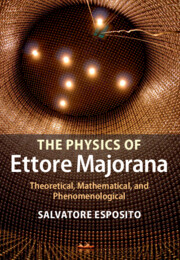Book contents
- Frontmatter
- Contents
- Acknowledgments
- Part I Introducing the character
- Part II Atomic physics
- 3 Two-electron problem
- 4 Thomas–Fermi model
- Part III Nuclear and statistical physics
- Part IV Relativistic fields and group theory
- Part V Quantum field theory
- Part VI Fundamental theories and other topics
- Part VII Beyond Majorana
- Appendix Molecular bonding in quantum mechanics
- References
- Author index
- Subject index
4 - Thomas–Fermi model
Published online by Cambridge University Press: 18 December 2014
- Frontmatter
- Contents
- Acknowledgments
- Part I Introducing the character
- Part II Atomic physics
- 3 Two-electron problem
- 4 Thomas–Fermi model
- Part III Nuclear and statistical physics
- Part IV Relativistic fields and group theory
- Part V Quantum field theory
- Part VI Fundamental theories and other topics
- Part VII Beyond Majorana
- Appendix Molecular bonding in quantum mechanics
- References
- Author index
- Subject index
Summary
The first meeting between Majorana and Fermi, as recalled in Chapter 1, focused on the statistical model of atoms, known as the Thomas–Fermi model. Fermi developed the idea of applying his statistical method (the Fermi–Dirac statistics) to the completely degenerate state of electrons in an atom, in order to evaluate the effective potential acting on the electrons themselves. He was aware of the fact that, since the number of electrons involved is usually only moderately large, the results obtained would not present a very high accuracy, but the method turned out to be very simple, and gave an easy-to-use expression for the screening of the Coulomb potential accounted for by electrons as a whole. This was one of Fermi's favorite issues, and the main activity of the Fermi group at the Institute of Physics in Rome from 1928 to 1932 was essentially devoted to this subject.
As testified by a number of his notes [17] (and as announced, very briefly, at a conference [203]), Majorana repeatedly studied this same subject, contributing some very important results in both atomic and molecular physics [204, 205, 206]. In the following we shall see that the amusing anecdote recounted in Chapter 1 was only the tip of an iceberg that Amaldi, Segrè, and Rasetti were allowed to see (even without a full understanding of it), since – true to his style – Majorana did not publish anything on the subject.
Fermi universal potential
The main idea of the statistical model of atoms is to consider the electrons around the atomic nucleus as a gas of particles at absolute zero temperature, all obeying the Pauli exclusion principle.
Thomas–Fermi equation
The limiting case of the Fermi–Dirac statistics for strong degeneracy applies to such a gas, and Thomas [207] and Fermi [208] independently realized that its potential energy −eV satisfied a second-order inhomogeneous differential equation with a term proportional to V3/2:
This equation allowed the evaluation of the potential inside an atom with atomic number Z, using boundary conditions such that for the radius r → 0 the potential becomes the Coulomb field of the nucleus, V(r) → Ze/r, while for r → ∞ it vanishes: V(r) → 0.
- Type
- Chapter
- Information
- The Physics of Ettore MajoranaTheoretical, Mathematical, and Phenomenological, pp. 83 - 106Publisher: Cambridge University PressPrint publication year: 2014



